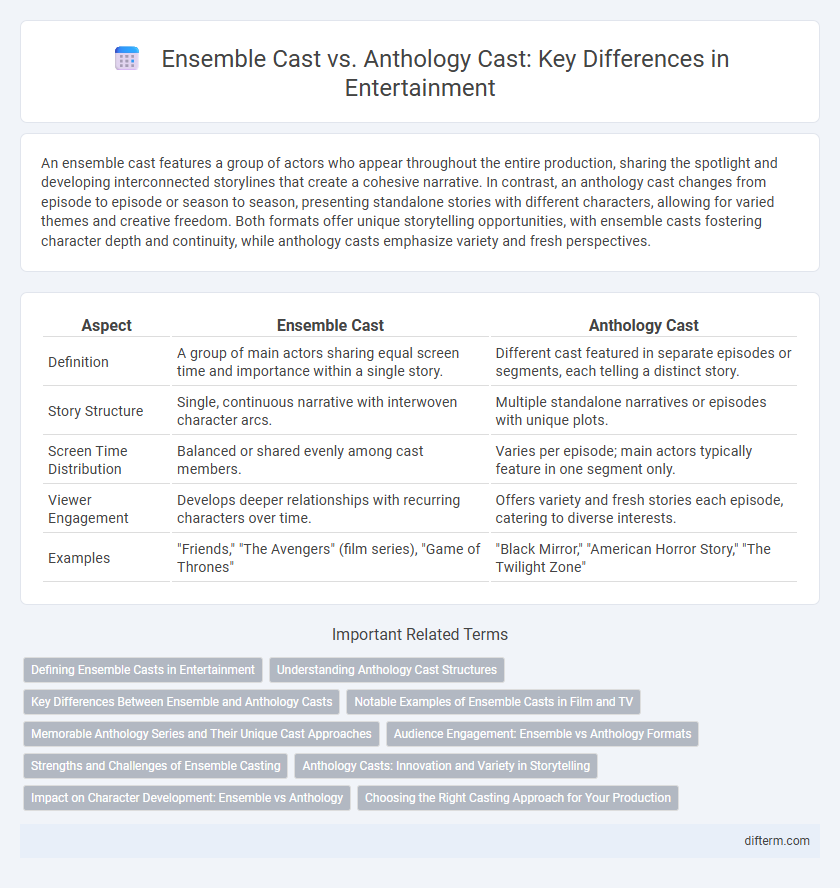An ensemble cast features a group of actors who appear throughout the entire production, sharing the spotlight and developing interconnected storylines that create a cohesive narrative. In contrast, an anthology cast changes from episode to episode or season to season, presenting standalone stories with different characters, allowing for varied themes and creative freedom. Both formats offer unique storytelling opportunities, with ensemble casts fostering character depth and continuity, while anthology casts emphasize variety and fresh perspectives.
Table of Comparison
| Aspect | Ensemble Cast | Anthology Cast |
|---|---|---|
| Definition | A group of main actors sharing equal screen time and importance within a single story. | Different cast featured in separate episodes or segments, each telling a distinct story. |
| Story Structure | Single, continuous narrative with interwoven character arcs. | Multiple standalone narratives or episodes with unique plots. |
| Screen Time Distribution | Balanced or shared evenly among cast members. | Varies per episode; main actors typically feature in one segment only. |
| Viewer Engagement | Develops deeper relationships with recurring characters over time. | Offers variety and fresh stories each episode, catering to diverse interests. |
| Examples | "Friends," "The Avengers" (film series), "Game of Thrones" | "Black Mirror," "American Horror Story," "The Twilight Zone" |
Defining Ensemble Casts in Entertainment
An ensemble cast in entertainment features a group of principal actors who share roughly equal screen time and narrative importance, contributing collectively to the storyline's progression. Unlike anthology casts, which are distinct and isolated per episode or segment, ensemble casts maintain continuous interaction and interconnected character development throughout the production. This structure enhances dynamic storytelling by weaving multiple perspectives into a cohesive narrative experience.
Understanding Anthology Cast Structures
Anthology cast structures feature different actors in each episode or season, offering distinct storylines and characters, unlike ensemble casts where the same group of actors portrays interconnected roles throughout the series. This format allows for diverse storytelling and fresh perspectives, attracting viewers who seek variety within a single show. Understanding the nuances of anthology casts helps appreciate creative flexibility and narrative innovation in contemporary television entertainment.
Key Differences Between Ensemble and Anthology Casts
Ensemble casts feature a consistent group of actors portraying interconnected characters across an entire series or film, fostering deep character development and ongoing story arcs. Anthology casts, by contrast, consist of different actors each season or episode, with standalone narratives unrelated to each other, emphasizing thematic variety over character continuity. The key difference lies in ensemble casts' sustained character interaction versus anthology casts' distinct, self-contained storytelling structures.
Notable Examples of Ensemble Casts in Film and TV
Ensemble casts in film and TV bring together multiple prominent actors who share significant screen time, as seen in notable examples like "The Avengers," "Ocean's Eleven," and the TV series "Game of Thrones." These productions rely on the chemistry and balance between stars such as Robert Downey Jr., Sandra Bullock, and Emilia Clarke to create dynamic storytelling. Unlike anthology casts, which feature different actors in separate storylines, ensemble casts maintain a consistent group of characters interacting within the same narrative framework.
Memorable Anthology Series and Their Unique Cast Approaches
Memorable anthology series like *American Horror Story* and *True Detective* employ a unique cast approach by featuring different characters and storylines each season, often reusing the same actors in new roles to create fresh yet familiar experiences. In contrast, ensemble cast shows such as *Friends* or *The Office* maintain a consistent group of characters throughout the series, allowing for deep character development and long-term audience attachment. The anthology cast approach emphasizes versatility and storytelling variety, while ensemble casts focus on character dynamics and evolving relationships over time.
Audience Engagement: Ensemble vs Anthology Formats
Ensemble casts foster continuous audience engagement by developing interconnected storylines and character relationships, creating a cohesive viewing experience that encourages emotional investment over time. Anthology casts offer fresh narratives and characters in each installment, appealing to viewers seeking variety but requiring renewed engagement efforts for each episode or season. Audience retention often proves stronger with ensembles due to familiarity and sustained character arcs, while anthologies thrive on novelty and thematic exploration.
Strengths and Challenges of Ensemble Casting
Ensemble casting offers the strength of dynamic character interactions and balanced screen time, fostering complex storylines through multiple protagonists that engage diverse audience interests. Challenges include managing the coordination of numerous actors, maintaining narrative cohesion, and ensuring character development does not become diluted across the cast. This approach contrasts with anthology casts, which focus on isolated stories with separate characters, enabling more concentrated storytelling but sacrificing the interconnected depth of ensemble productions.
Anthology Casts: Innovation and Variety in Storytelling
Anthology casts bring innovation and variety to storytelling by featuring different characters and actors in each episode or season, enabling diverse narratives and creative freedom. This format allows writers to explore multiple genres and themes without being confined to a single storyline, appealing to a broad audience. The rotating ensemble introduces fresh perspectives and maintains viewer engagement through unpredictability and dynamic character development.
Impact on Character Development: Ensemble vs Anthology
Ensemble casts enable extensive character development through ongoing interactions and evolving relationships across multiple episodes or seasons, fostering deep audience investment. Anthology casts present distinct characters in each installment, limiting prolonged character arcs but allowing diverse storytelling and thematic exploration. The impact on character development hinges on ensemble continuity versus anthology variety, shaping narrative depth and emotional engagement.
Choosing the Right Casting Approach for Your Production
An ensemble cast features a group of actors sharing roughly equal screen time, ideal for stories with interconnected plots and character development, promoting dynamic interactions and chemistry. An anthology cast consists of different actors for each episode or segment, suitable for varied narratives or themes within a single series, offering flexibility and fresh perspectives. Selecting between ensemble and anthology casts depends on the narrative structure, production goals, and audience engagement strategy to optimize storytelling effectiveness.
Ensemble cast vs anthology cast Infographic

 difterm.com
difterm.com